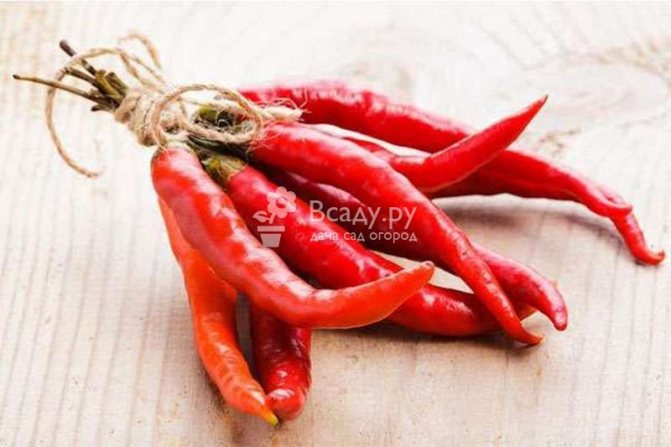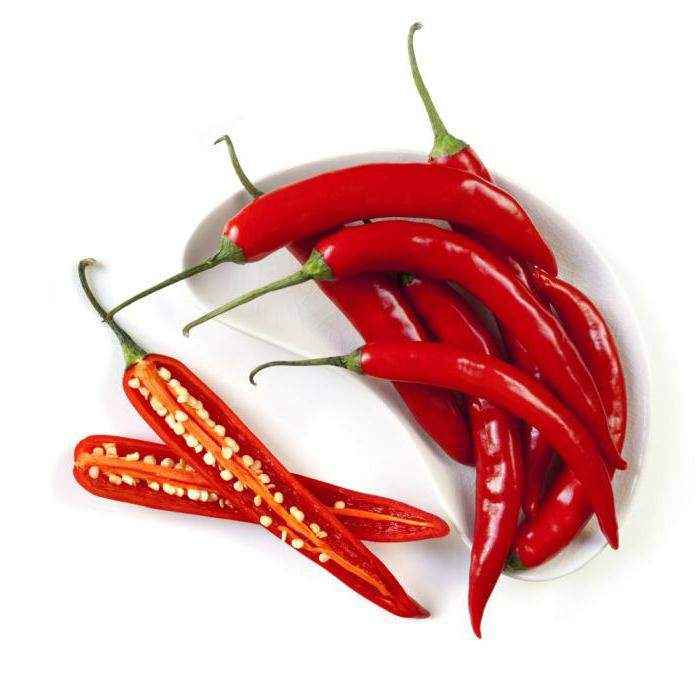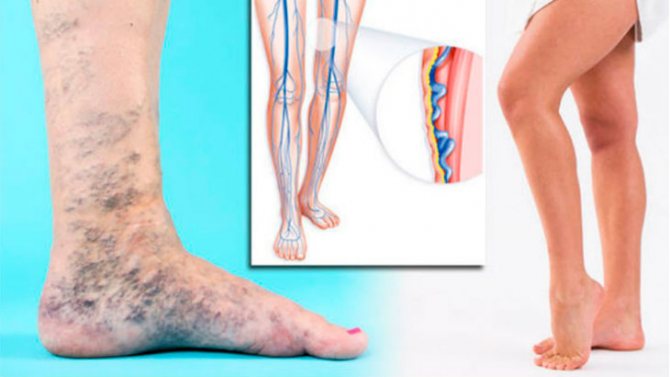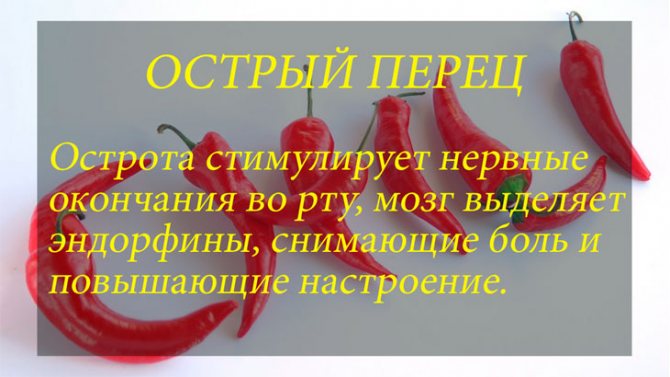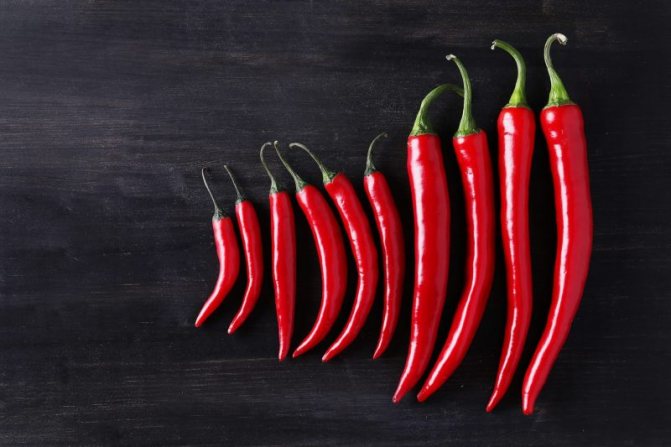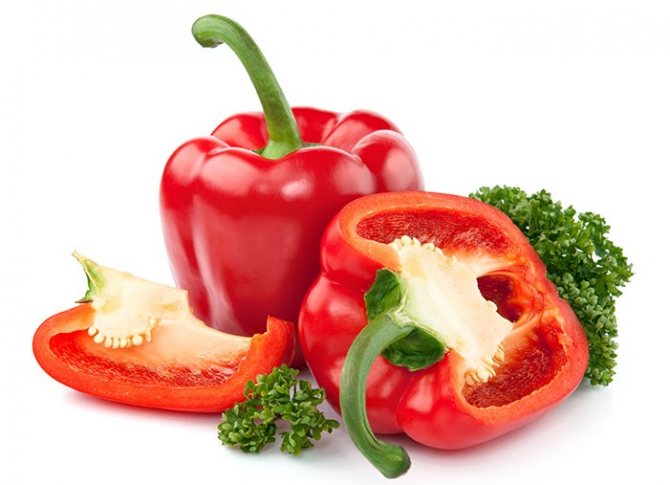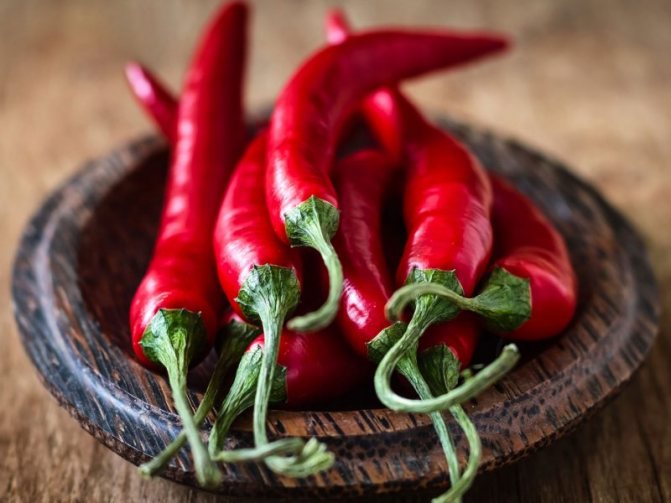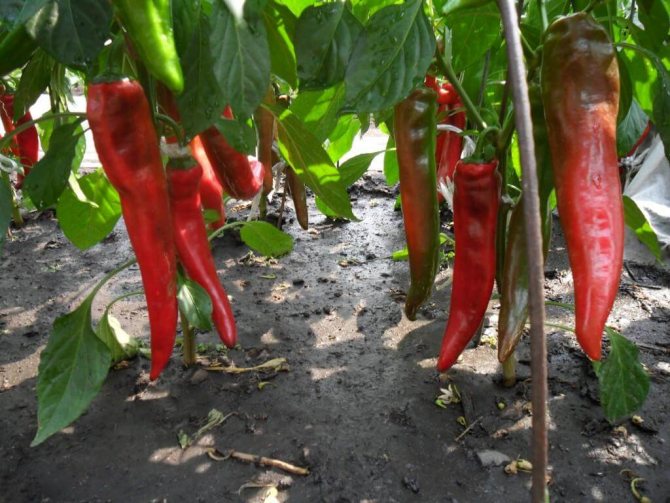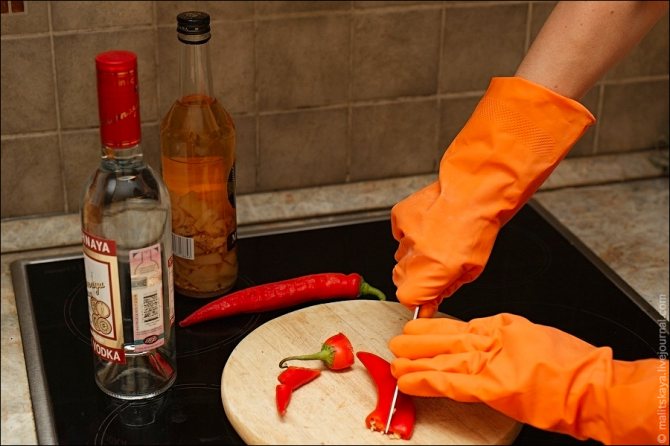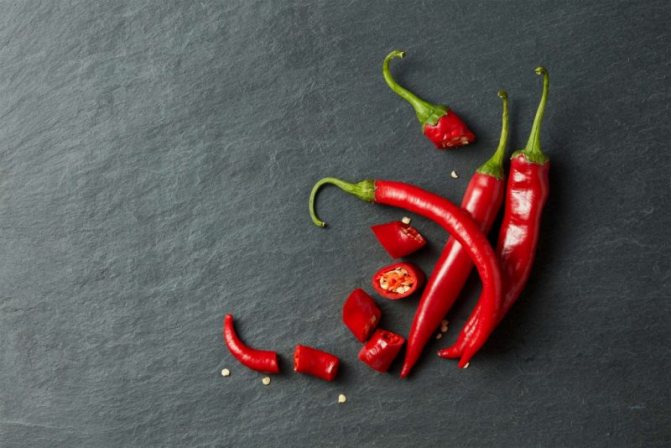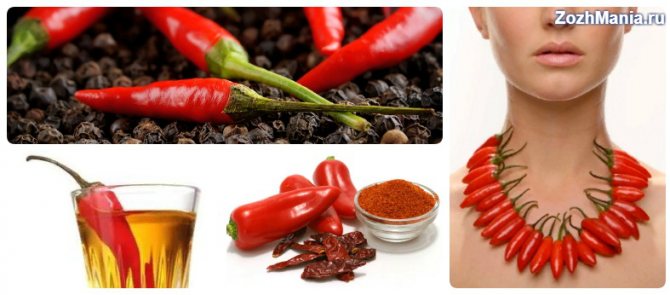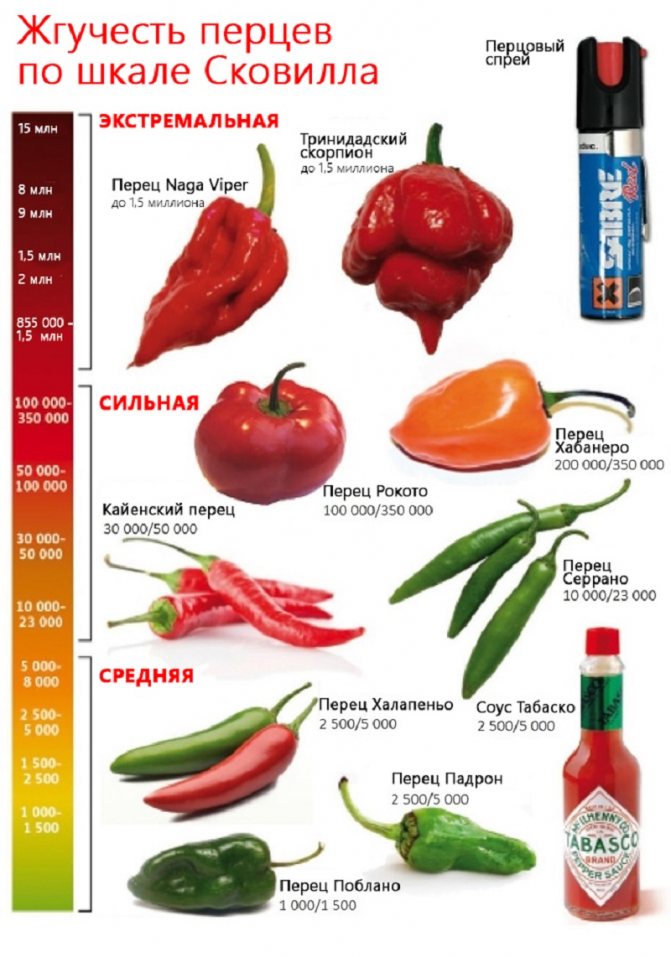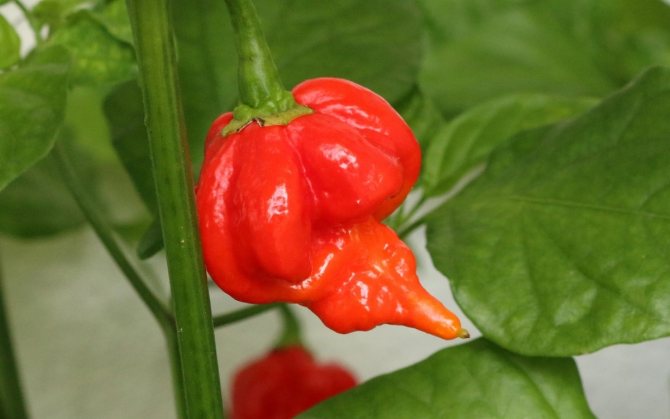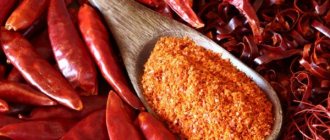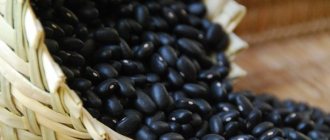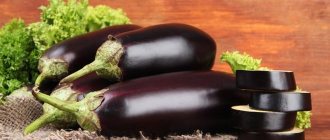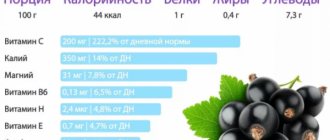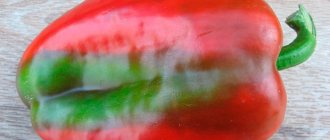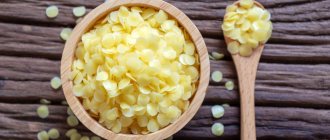It is difficult to scientifically explain a person's love for spicy food, but a quarter of the world's people consume a hot vegetable of the Pepper family every day. It is believed that the seeds are the hottest part, but in fact, most of the capsaicin contains white septa inside. By connecting to receptors on the tongue, this alkaloid causes a burning sensation on the mucous membrane, and the higher the capsaicin level, the more painful this feeling will be.
In nature, birds are the carriers of seeds and, surprisingly, they lack the receptors that prevent mammals from eating vegetables. However, a person was able to "tame" red hot pepper, and having studied its composition, he was able to minimize the harm when consumed, because the benefits of the hot seasoning for the body are very great.
75% of pathogenic bacteria that cause intestinal poisoning are neutralized by the active substances of the fire seasoning. Moderate use helps to heal and rejuvenate the body, while uncontrolled use will cause significant damage to health.
History
This product is widely used as a spice. Perhaps many will be surprised, but there are several of its species, which are brought from different countries of the world: India, East Asia, America. Depending on the country in which the pepper was grown, it has different taste properties: some of them are distinguished by a high level of pungency, and some are more pungent, which is noticeable when you first touch the ground seasoning.
This product settled on the territory of Russia quite a long time ago - in the 16th century. Even then, it was brought by merchants and, due to its high cost, was used only by wealthy people. Later, it began to be grown in the regions of the Krasnodar Territory and the Volga region - it is these lands that are currently considered the most suitable for the cultivation of this agricultural crop.
Bitter pepper in the garden
Despite the fact that hot pepper is a tropical culture, it has long been cultivated practically throughout Russia. Although in the northern regions you will have to tinker a little with seedlings, which are best grown at home. People who do not have a summer cottage or vegetable garden should not despair, since pepper can also be grown in an apartment on a windowsill, even in winter.
If the weather conditions are favorable (lots of sun and little rain), you can harvest in mid-July. Caring for a plant in the open field does not present any particular problems. It is enough to water as it dries, loosen the ground and remove weeds. As for dressing, everything is individual here. If the gardener wants to get a harvest faster and in large quantities, then it is permissible to use complex mineral fertilizers.
A much more important issue is the neighborhood with bitter pepper. The fear that the culture can transmit bitterness to the rest of the plants is not justified. Only the neighborhood with bell peppers can bring a similar result. Two similar crops pollinate each other, and as a result, the whole crop will turn out to be bitter.
In this case, it is necessary to be guided only by which plants planted nearby will have a positive effect on the growth of pepper and prevent the culture from getting sick. Tomatoes and eggplants are some of the best neighbors for red peppers.These cultures help each other grow. In addition, hot pepper repels some insects. Often, tinctures based on this vegetable are used to protect against pests. Spraying with hot pepper solutions helps to get rid of aphids. Herbs such as dill, basil, cilantro and thyme can also be planted nearby.

But fennel, beets and potatoes are best planted as far away from hot peppers as possible. The latter will take away all nutrients and moisture, and the listed crops will suffer from this.
Vitamins
Red pepper has beneficial properties due to the presence of trace elements and minerals in its composition, which have a certain effect on the human body. So, in the composition of each peppercorn there is a considerable content of carotene, due to which its red color is ensured. In addition, experts distinguish a high content in the structure of such a product of vitamins of group B, C and A. In addition to all this, in the structure of pepper one can observe such components as proteins and sugar, as well as a high content of essential oils, which are very often used in medicine and cosmetology.
In addition to all this, among the useful components you can find such names as phosphorus, sodium, as well as selenium and zinc, which have the most beneficial effect on various systems of human organs. In addition to vitamins and microelements, red hot pepper contains several types of fatty acids: oleic, capric, palmitoleic, myristic, and lauric. In addition, this fresh seasoning has a low content of Omega-3 and Omega-6.
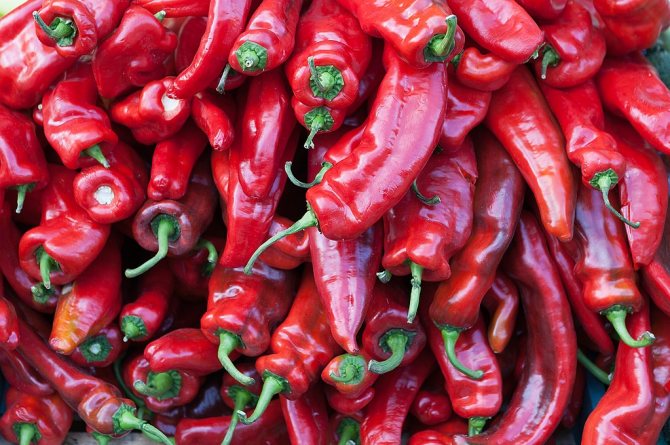

The chemical composition and health benefits of hot red peppers
Hot pepper has a very rich chemical composition, and the amount of some elements covers the daily intake of the body. The vegetable is saturated with the following substances:
- Vitamins:
- group B - it is difficult to name the daily dose of this vitamin, since it is influenced by many factors, including age, gender, occupation, season, etc. An increased level of anxiety in modern society indicates that this group is indicated everyone, as it affects the normal functioning of the nervous system. Cell growth and division also depends on the availability of these substances in sufficient quantities;


B vitamins - tocopherol (E) - antioxidant, slows down the aging of cells and provides them with more intense nutrition. Responsible for cell regeneration, blood circulation, muscle function and much more. It is of particular importance at the stage of planning pregnancy and bearing a child. The daily allowance for an adult is 8 mg for women and 10 for men;
- PP - is essential for the proper functioning of many systems in the body. Reduces the risk of heart disease, including heart attack. Takes part in the synthesis of hormones, the production of enzymes and the assimilation of protein;


Properties of vitamin PP - K - maintains healthy blood clotting indicators, prevents calcium deposition in blood vessels, serves as a prophylaxis for liver and prostate oncology;
- alpha-, beta-carotenes - prevention of ophthalmic diseases;
- lutein and zeaxanthin - improve cognitive function and vision. Also, in combination with other vitamins, they improve the functioning of the lungs, heart, and lower cholesterol levels.
ascorbic acid (C) is an antioxidant that triggers immune processes and is indispensable in protecting against infections. Also participates in hematopoiesis, tissue growth and metabolic processes in the body. The average daily allowance is 70-90 mg, but depends on many factors, so it can vary. Higher dosages are needed during lactation, pregnancy and the elderly. Also, smokers, regardless of age, belong to this category, since 1 cigarette destroys 25 mg of the vitamin.
Interesting!
The amount of this vitamin in 100 grams of hot pepper exceeds the daily requirement by 2.5 times;
- potassium - has a beneficial effect on the heart, brain, soft tissues, reduces edema by regulating the content of salts and acids in the body;


The benefits of magnesium for the body
- boron - participates in the metabolism. Increases the level of estrogen in the blood, maintains the required level of calcium;
Also, the chemical composition includes 9 essential amino acids and 9 nonessential, 18 types of fatty acids, as well as purines and sterols.
Based on the chemical composition, hot pepper has the following health benefits:
- lowers cholesterol;
- has antibacterial, antiviral, immunostimulating and analgesic effects;
- improves the condition of blood vessels, bones, cartilage and soft tissues;
- serves as the prevention of many cardiovascular diseases;
- prolongs youth due to antioxidant action;
- has anti-cancer properties;
- improves blood circulation in the brain.
Beneficial features
Hot peppers are considered to be a very useful ingredient, especially when used correctly in cooking. This seasoning is able to awaken the appetite, thereby improving the functioning of the digestive system of the body. In addition, it has a beneficial effect on the work of the pancreas, stimulating it to produce vital enzymes.
Some doctors have noticed the beneficial properties of red hot pepper, which are aimed at the work of the heart and blood vessels. According to many studies, people who regularly eat red peppers do not have vision problems. However, this feature applies only to those people who consume red chili peppers - those who like to use it in ground form as a seasoning can not be fooled. Often such a product is used for the prevention and treatment of arthritis and rheumatism.
Vitamins contained in red pepper have a beneficial effect on strengthening the immune system.
Benefit
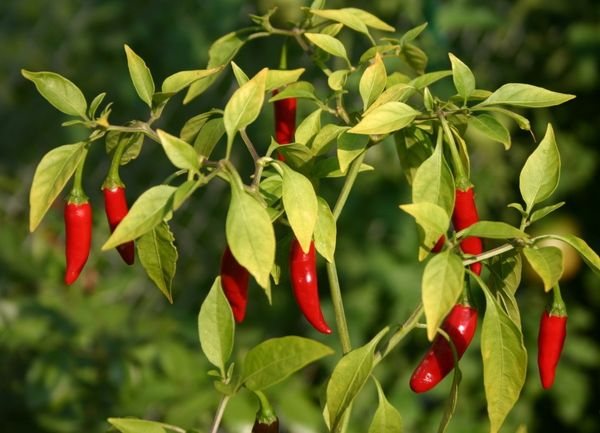

Bitter pepper contributes to the overall strengthening of the body
There is an opinion about the harmfulness of bitter pepper, however, with moderate use, the vegetable contributes to the overall strengthening of the body human, improves digestion and strengthens the immune system.
A vegetable rich in many useful macro- and microelements, has a lot of useful properties:
- regular eating improves condition central nervous system, promotes the treatment of insomnia and increases stress resistance;
- the hematopoietic function of the body is normalized, the work of the cardiovascular system improves;
- enhances the activity of the brain and the flow of oxygen to vital organs;
- minimizes risk disease of atherosclerosis, asthma and renal failure;
- provokes the release of hormones of happiness;
- has a bactericidal effect on both internal and external tissues of the body.
Negative properties
As you know, even the most healthy foods, if consumed excessively or improperly, can be harmful. The same rule applies to peppers. A separate risk area that should be paid attention to all fans of such a product is the gastrointestinal tract, since it is in this part of the body that it has the most active effect. Chili recipes are not suitable for those people who suffer from diseases such as gastritis, stomach ulcers, intestinal ulcers, or other diseases associated with the digestive system. It should also be avoided by those who suffer from liver disease, as well as diabetes.
Such a product is also contraindicated for pronounced allergy sufferers. Its enzymes can only exacerbate the manifestations of such a disease.
The main contraindications and harm of hot pepper to the body
Chili pepper is a very hot spice, therefore it has a number of contraindications, in which you can not use the seasoning on a regular basis:
- diseases of the gastrointestinal tract, even in remission. The components of the product irritate the mucous membranes, which may cause diarrhea, vomiting, heartburn or nausea;
- diseases of the cardiovascular system;
- liver disease in the acute stage;
- kidney disease;
- individual intolerance to the components, which can be expressed in an allergic reaction of varying severity;
- childhood.
Important!
It is worth noting that the spice can be harmful not only in cases where it is contraindicated. Regular consumption in large doses can negatively affect the body, for example, disrupt the functioning of the intestines and stomach.
With pathologies of the mucous membrane in the mouth, pepper in the composition of dishes can cause a strong burning sensation and aggravate the course of the disease. The degree of painful sensation will depend on the type of vegetable. To reduce the burning sensation, it is recommended to keep ice in your mouth or drink cold milk, kefir, yogurt.
Excessive amounts of hot peppers in the diet can do the following harm:
- burn of the gastrointestinal mucosa;
- increased stress on the heart;
- increased blood pressure;
- the development of stomach diseases (even cancer) with a constant inflammatory process.
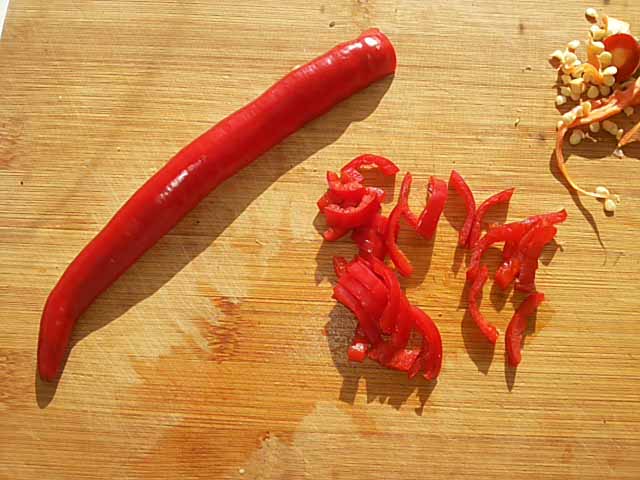

You need to be very careful when cutting the product.
It is best to carry it out with gloves so that there is no risk of damaging the mucous membranes of the eyes and nose with insufficient treatment of hands after contact with burning seasoning. Also, especially acute varieties can cause skin burns and severe pain.
During pregnancy, hot pepper in the diet will help to cope with vomiting with toxicosis, as well as normalize hormonal levels. But all the positive aspects of the use take place only with small doses.
When breastfeeding, spice should be completely eliminated, as it will affect the quality of milk. In childhood, the vegetable is also completely excluded so as not to injure the forming intestine.
Cooking applications
Most often, ground pepper is used in the preparation of all kinds of dishes. Many experts recommend that you definitely add it to food, which is characterized by a difficult digestion process, in particular, in meat dishes. Nutritionists, in turn, note the low calorie content of pepper and its positive effect on metabolism.
A spice such as red hot pepper is widely used in cooking in combination with other spices and herbs. Many culinary experts recommend pairing it with nutmeg or chocolate.The spice added in the correct proportion can give the finished sauce not only an original aroma, but also a noble red tint.
In its pure form, the vegetable can be pickled or added to alcoholic homemade infusions.
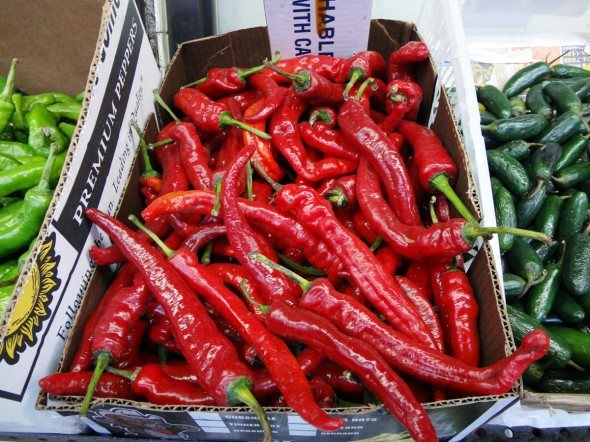

Application
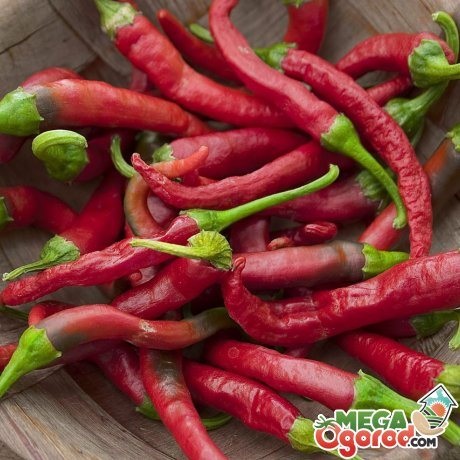

Hot peppers are respected in the cuisines of countries such as Italy, France, Hungary, India, Mexico. Most often it is added to meat and fish dishes, soups and side dishes. Capsicum is appropriate in vegetable dishes and canning.
Dry crushed peppers are used as a spice.
The spice is included in many seasonings, and also combined with spices - basil, thyme, coriander, garlic and others. Bitter pepper is an excellent cure for many diseases. It is widely practiced in folk and official medicine - pepper plaster and pepper tincture are well known to everyone. Topical application of the warming properties of pepper helps with sciatica, joint pain and frostbite.
Bitter pepper is also used in cosmetology: it is added to oils and lotions, they rejuvenate the skin of the body and make it more elastic. Quite often, pepper is included in anti-cellulite creams. Adding juice to hair care products will increase blood circulation and stimulate hair follicles.
Application in cosmetology
A large number of cosmetologists also pay attention to the benefits and harms of red pepper. In particular, the essential oils of this product are used to make anti-cellulite cream or as part of warming cosmetics. The product shows an excellent effect in the process of burning fat deposits - which is why it is often used for wraps.
The positive properties of such a product in hair loss have long been known. In the event that there is such a problem, it is enough to periodically rub the pepper tincture into the scalp. As practice shows, as a result of this application, the hair will not only become stronger, it will look healthier, and its growth will also noticeably accelerate.
Hand and nail masks that contain pepper or pepper extracts also have a positive effect. As a result of their regular use, a significant strengthening of the nail plate, as well as its growth, will be noticeable. In addition, this procedure helps to prevent the appearance and development of fungus.
The use of red hot pepper in the field of beauty
Hot peppers are relevant not only for health, but also for improving the appearance.


So, this plant is actively involved in the following processes:
- Strengthening hair, improving its condition.
- Skin rejuvenation. It is noted that people who regularly consumed red chilli look much younger than their biological age. Pepper masks help to solve multiple dermatological problems.
- Fight cellulite. Pepper allows you to lose weight and eliminate orange peel at the same time.
Hair mask with red pepper
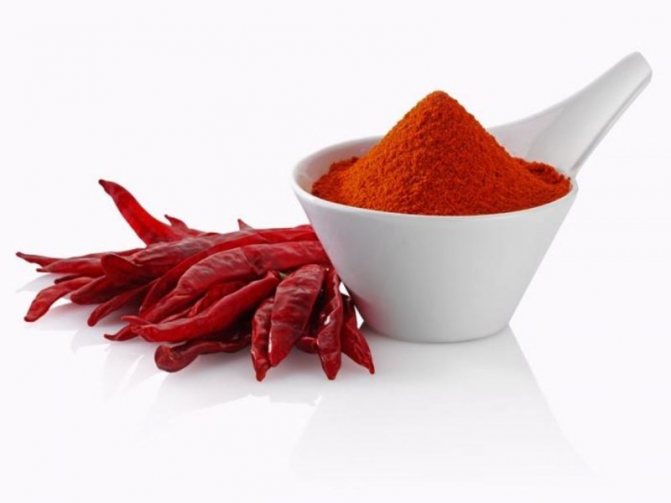

Ingredients:
- dry ground red pepper - 1 tbsp. l .;
- egg yolk - 1 pc .;
- olive oil - 1 tbsp. l .;
- cognac - 20 ml;
- lemon juice — 2 tsp.
Stir the ingredients and distribute to dry hair. Warm the head and leave to absorb for 30 minutes. The mass must be thoroughly washed off with shampoo and warm water.
Anti-cellulite wrap
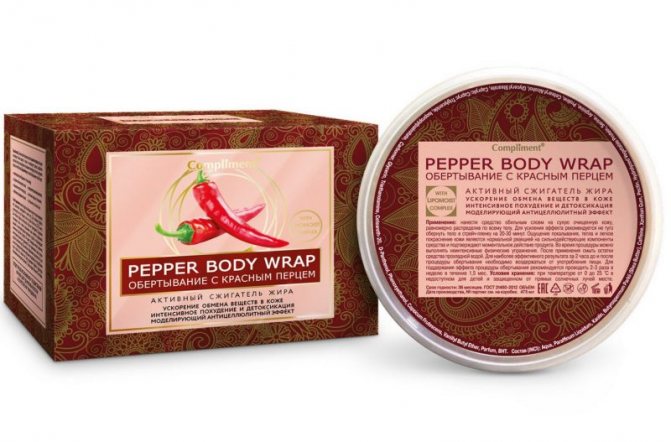

The product contains ground red pepper, cayenne pepper essential oil, nutmeg. Each specified ingredient must be taken 5 grams. Add 2 tbsp to them. l. olive oil, 100 g of honey (liquid) and 1 tbsp. l. heavy cream. All of these components are mixed and distributed over problem areas of the skin with the most gentle massaging movements.
Important. This composition should not be applied to wounds, abrasions, mucous membranes and skin of the chest. The duration of the wraps is 15 minutes, their frequency is 1-2 times a week.
Application in medicine
Knowing about the benefits and dangers of red pepper, you can widely use it in medicine. This product is incredibly useful in this area due to its burning properties.
A slice of pepper will be an excellent way to bring a person to their senses in case of fainting - it must be placed under the tongue. Rubbing their legs with them, you can save a person from hypothermia of the feet, and rubbing with the development of inflammatory processes or flu will immediately prevent the progression of ailments.
Hot peppers have excellent antipyretic properties that can be used at the very beginning of an infection in the body. In order to prevent its spread, you should stir the ground seasoning with honey in a 1: 1 ratio and eat one teaspoon three times a day. In order for the mass to have a more pleasant taste, it can be mixed with milk.
In medicine, pepper plasters are widely used, which can be purchased at pharmacies in any city. They are prescribed for arthritis, rheumatic pain, and muscle and joint diseases. Special attention is also paid to plasters, which are prescribed for colds - they are glued in the throat and chest area. If necessary, you can prepare such a remedy yourself: for this you need to chop the slightly dried fruits of the vegetable and, after rewinding the mass with gauze, attach it to the sore spot.


Can hot peppers be frozen?
Many housewives will be interested to know if hot peppers can be frozen for the winter in order to preserve their properties. We will help you find out how to do it correctly with a preparatory stage:
- First, you should clean the pepper from dirt and rinse it thoroughly.
- Then completely immerse the pepper in cold water, dry with a towel.
- If you want to reduce the pungency of the product, place the pepper in boiling water for 3 minutes.
- Next, we remove the core and seeds - the veins are cleaned, which reduces the bitterness in the subsequent consumption of the product.
- The thinner the pods are cut into strips, the better they will last for several months.
- When handling the core, rubber gloves should be worn. This will help keep the sharpness off your hands.
Next, we start freezing, and for this we choose one of the suitable options:
- It is necessary to determine the depth of freezing and the duration of storage. Chile is 90% water, and its safety is determined using the correct temperature regime.
- At 0-5 degrees, peppers can be stored for 1-2 months. It is impossible longer, otherwise the destruction of the integrity of the cells will occur.
- When stored at 0-2 degrees Celsius, pepper simply retains its properties, but in this position it will only be useful for 3 weeks.
- With prolonged freezing at -18 degrees, it will retain its properties for 1-2 years.
For instant freezing, it is best to use a gentle temperature. You need to store it in a glass container, and for a container, place chopped peppers in a container at temperatures up to -6 degrees. You can also store the pepper in oil - this way it will retain its properties longer, but you cannot refreeze it when defrosting.
If hot pepper gets in your eyes, what to do?
It will be useful for many housewives to find out what to do if hot peppers get into their eyes. This can happen during cooking, preparatory cleaning or freezing. No one is immune from such a case, and when it happens (we do not croak). You will already know what to do in these emergencies.
- Always from a burning sensation in the eyes, black tea, or calendula, helped. A weak chamomile solution will also relieve the burning sensation, and you can rinse the eyeball with this composition. If pepper gets into both eyes, then the liquid must be replaced after rinsing the first eye.
- If the eyelid is affected, poultices are applied - cotton pads are moistened in hot or cold-type black tea tincture, and applied to the eyes for 5 minutes.
- Goat milk will help with the pain after burning. Cotton pads are also used to relieve redness and tingling in the eyes.
After rinsing, you need to drip the eyes with a medical solution, which will prevent the development of infection. Purchase in advance Albucid is an anti-inflammatory agent that blocks bactericidal inflammatory processes.
Hands are burning from hot pepper - what to do?
After working with the product, it often happens that hands burn from hot pepper. What to do in such cases to prevent swelling? Vegetable oil and milk are home remedies. Not related to household chemicals. Therefore, such measures should be resorted to last. And first of all, take care of such solutions:
- Chlorine lime and water. For disinfection and removal of redness, chlorine is used, which removes bacteria, and neutralizes it with water. Burning hands should be washed with a non-concentrated solution. It won't get worse if your hands are burning after pepper.
- Liquid soap and soda. This is sodium bicarbonate, which helps everywhere in the home, and it will save your hands too. Porridge is prepared with liquid soap, which neutralizes excess alkali. The mass is applied to the affected areas of the body, and then washed off with water.
- Alcohol helps dissolve capsaicin, a substance that causes itching, burning, and redness. Alcohol-based lotions, tonics and perfumes (eau de toilette) can help you with this issue.
Do not forget to rinse your hands under running water, disinfect them after processing. Then the procedure should be repeated if it was not possible to completely remove the swelling and redness.
Other uses of red pepper
Few know the results of some observations of scientists, which also indicate the benefits of red pepper in any form. So, they note that this product perfectly cheers up those who use it regularly, even in small portions. In addition, not so long ago, well-known oncologists conducted a study, during which they found that such a product prevents cell mutation, which prevents the formation of cancerous tumors. Of course, in the modern world, when tumor diseases have become quite common, this discovery plays an important role.
Why is a hot vegetable useful?
It is believed that hot peppers do not benefit the body, since they are believed to irritate the stomach lining. It is clear that in unreasonable application and use, this is exactly how it can be. However, at the same time, using chili pepper restores the work of the circulatory, digestive and respiratory systems, improves appetite, and normalizes stool.
Red pepper is capable of producing the "happiness" hormone in the human body. For example, endorphins relieve stress and increase human immunity.
Speaking of the amazing properties of a spicy red vegetable, it should be noted antibacterial, antidiabetic and analgesic effect... What else can red pepper do? Let's consider some facts:
- Normalizes the work of the heart. Capsaicin significantly lowers cholesterol levels, and therefore reduces the risk of atherosclerosis, thrombosis and other diseases.
- Reduces weight. Few know about it. Pepper normalizes metabolism, stimulates the breakdown of fatty deposits.
- Relieves headaches.
- It is an excellent prophylactic agent for gastrointestinal diseases. The product is able to reduce inflammation and destroy bacteria that cause gastritis.
- Normalizes blood pressure.
- Fights infectious diseases and colds.
- Chili peppers are effective for psoriasis and diabetes.
- Hot peppers are especially good for men. It has a beneficial effect on male strength. An interesting experiment was carried out in France. After eating, saliva was collected from each participant.Those who regularly consumed chili sauce had fairly high levels of the main male hormone, testosterone.
Not only the pulp of a hot vegetable benefits the body. It should be noted and its seeds, which are also saturated with vitamins, micro- and macroelements.
Dangers of external use
How to use red pepper for external use correctly? After all, many are aware of its irritating and scalding properties. First of all, you should pay attention to the fact that the skin on which the composition with such an ingredient will be applied does not have a high level of irritability and does not have any damage in the form of wounds or scratches. It is also not recommended to use such a component for those people who experience problems with veins, and those whose skin is prone to allergic reactions.
Speaking about the benefits and harms of red pepper, many lovers of using this product through external use give some advice in case a skin burn was nevertheless obtained. If this happens, it is enough to lubricate the damaged area with vegetable oil, after rinsing the area with plain water. Thus, it is possible to reduce painful sensations, as well as accelerate the process of regeneration of skin cells.


Hot peppers for weight loss - how to eat?
It is worth noting another positive side of red hot pepper - it is a low-calorie product, which, in addition to enhancing metabolism, breaks down carbohydrates and fats. But how to eat hot pepper for weight loss in order to lose weight and not harm your health?
It is best to make a pepper tincture that is moderately hot. The vegetable is placed in vodka or alcohol, infused for 5 days. It is important to finely grind the pepper so that it releases all the juices and saturates the tincture with its substances. If instead of medical alcohol (90%) you use vodka, then you need to insist on it for 3-4 weeks. For weight loss, take 30 ml three times a day half an hour before meals. At the same time, you cannot repeat the course every month - the exposure between sessions is six months, and the duration of one weight loss course lasts no more than 2 weeks.
For the best result, according to experts of the Oncological Institute, you should add seasoning to food, and not just drink tinctures.
How to store
In order for red pepper not to lose its properties, it is necessary to organize proper storage for it. So, the best conditions for a fresh legume vegetable can be arranged in the refrigerator, after wrapping it in cling film or a plastic bag. In this form, it can be stored for no more than one week - otherwise it will begin to fade and, as a result, lose its invaluable properties. In order to increase the period of possible storage, you can pre-treat the vegetable pods with vegetable oil or vinegar - in this form, it will stay fresh for one month.
It is not recommended to store the pepper in ground form for a long period - so it quickly loses its properties: for example, after two to three days it will be unsuitable for treatment. If you want to keep the product dry, it is best to tie it up and hang it in a dark and dry place.
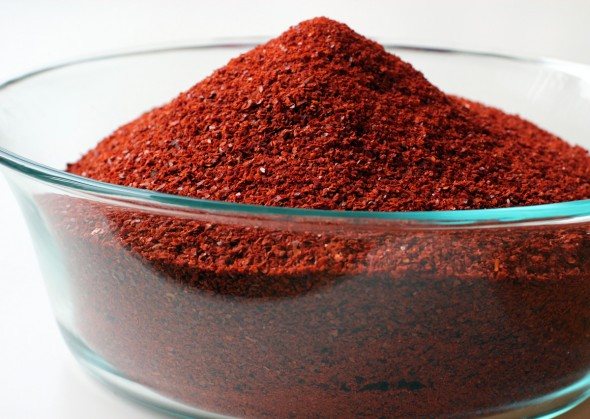

The best varieties and tips for growing peppers
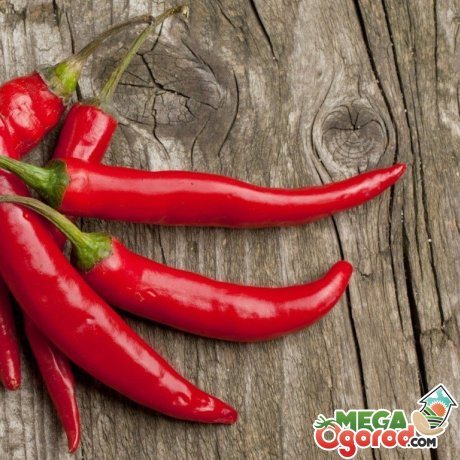

With a variety of positive and negative properties and qualities of pepper, it is worthy of attention. And thus causes excitement to try to grow this wonderful berry on your own. The key to a good harvest lies in choosing the right plant variety and caring for it.
Before you start choosing a variety, decide where you will grow it - in the garden, in the greenhouse or on the window in the apartment? How quickly do you want to harvest? Some varieties ripen quickly, while others "pull to the last." What yield do you want to have?
Many varieties produce a large amount of fruit and do not have to plant a pepper plantation. Basically, hot pepper varieties are divided into two types - piquant and shrub:
- The spicy species has a sharp and bright taste. It is usually used raw, since the peppercorns are long and inconvenient to dry.
- Shrubs will perfectly take root at home as an ornamental plant. Its fruits are edible, dried and added to seasonings.
Popular varieties of hot pepper:
- Cayenne pepper. A common variety of hot pepper. It is used dry and fresh in soups, vegetable or meat dishes. Suitable for the production of ketchup.
- Jalapeno. Mexican variety. Medium pungency. The plant is thermophilic, therefore a greenhouse and a greenhouse are the best places for growing. The fruits are harvested in green. Add to salads.
- Hungarian waxy yellow. The variety is neither spicy nor demanding. Suitable for pickling and stuffing.
- Chinese fire. The fruits of this pepper are both pickled and eaten raw. Peppercorns reach a length of 25 cm, unpretentious to growing conditions.


Let's start landing. Experts believe that the best way to grow peppers is from seeds. Their germination capacity, with proper care, lasts up to 3-4 years. It is advisable to start the process of growing seedlings in February, in order to plant peppers in open ground in the spring.
- Soak the seeds in water for a while. This is necessary for their better germination.
- We prepare the soil and fill it with containers for planting
- We make holes in the soil with a match or a toothpick.
- We plant the prepared seeds in containers. The desired room temperature is at least 25 degrees.
- The containers are closed with a bar and removed to a bright and warm place.
- When the sprouts hatch, it is advisable to reduce the temperature in the room by 2-4 degrees.
- Young seedlings require regular watering. Drying and waterlogging should not be allowed.
- Bushes that have grown to 25-30 centimeters are recommended to be planted in open ground, where onions or carrots previously grew.
- The desired temperature by the time of disembarkation is 15-17 degrees. It is better to do this on a cloudy day, or in the evening, avoiding direct sunlight.
- The seedlings are removed from the containers together with the soil and planted in holes. The wells are watered abundantly. The size of the hole should be approximately the same as the size of the container. It is advisable not to seedlings with bare roots.
- The landing pattern corresponds to the size 40cmx50cm. These distances increase or decrease, depending on the variety of pepper, the larger the bush, the wider the distance between the seedlings.
The first few days after planting seedlings in the ground, the pepper looks sluggish. This is because the root system suffers during transplantation and the plant is under stress. It takes some time to adapt. During this period of time, the main thing is not to overdo it with watering. Waterlogging is not permissible, as thin roots will rot. The first abundant watering is necessary a week after planting. Further care of the plant consists in periodic watering, feeding and weeding.
How to choose the right pepper
When purchasing pepper in the market or in a store, you need to pay attention to its appearance - it is he who speaks about how useful the product will be.
In the event that you need to purchase a fresh vegetable, you should give preference to red pods - the brighter their color, the more vitamins they contain. In appearance, it should be smooth and shiny, and very elastic to the touch - this indicates the freshness of the vegetable.
In the event that dried peppers are purchased, then you also need to pay attention to the color. The ideal pepper will be dark red and of a solid color. In the event that the fruit has orange blotches, you should avoid buying it, as this indicates harmful bacteria that have settled in it during the drying process - such a spice is unsuitable for food. The dried pepper must have an ideal surface, there can be no cracks on it - their presence indicates the loss of nutrients.
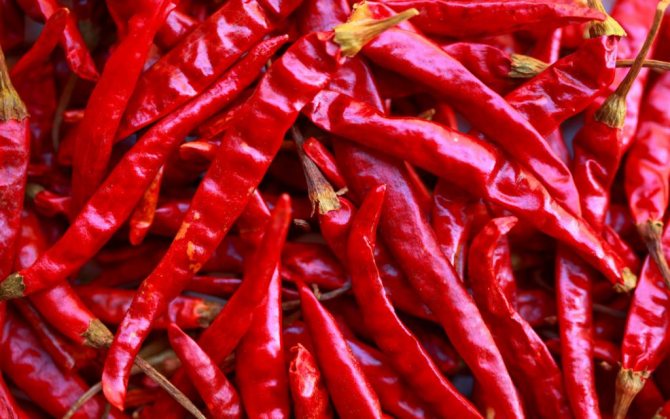

Composition and properties
There are many varieties of hot pepper in the world, among themselves they differ in the shape of the fruit and the degree of pungency. The vegetable can be grown both outdoors and at home, which means that it is available to everyone and at any time of the year.
Regardless of the variety, pepper has a rich and unique vitamin and mineral composition. It contains vitamins A, B1, B2, B6, C, E, K, PP, beta-carotene, phosphorus, choline, iron, potassium and essential oils. Also, the vegetable contains a large amount of ascorbic acid.
For 100 g of the product there are:
- proteins - 1.38 g;
- fat - 0.33 g;
- carbohydrates - 7.31 g.
The calorie content of the vegetable is only 40 kcal per 100 g.
When you eat pepper, you will feel a very hot, but at the same time, pleasant taste. Many people are even "addicted" to this savory vegetable. It is due to the fact that our taste buds react to the burning substance capsaicin and provoke the production of happiness hormones - endorphins.
The product is widely used both in folk medicine and in pharmacology. On its basis, ointments and sprays are made against the common cold and joint pain.


For pregnant women and children
Most doctors do not recommend that pregnant women eat any form of red pepper. According to them, this product can adversely affect the development of the fetus. In addition, a woman, eating even a small amount of red pepper during pregnancy, runs the risk of getting heartburn, which can only cause discomfort. While breastfeeding, the use of such a product is also not recommended. This is due to the fact that, through breast milk, the components that make up the pepper will enter the stomach of a small child and cause heartburn in him, as well as more serious diseases of the digestive system. Pediatricians generally do not recommend giving a baby spicy foods and dishes for food - they adversely affect the gastric mucosa, as well as health in general.
Harm and contraindications
Bell peppers are generally well tolerated by the body. It is extremely rare (less than 0.01%) of cases to develop allergic reactions. Cases of cross-allergy (allergy to pollen) have also been reported.
Allergic pathologies can manifest themselves in different ways: both "banal" reactions (urticaria) and extremely dangerous complications (anaphylactic shock) are described.
It is important to note that bell peppers are recommended for inclusion in the diet of women during pregnancy. The vegetable does not have a significant effect on the mother's body, but it is extremely important for the adequate formation of the fetal neural tube due to the presence of folic acid (vitamin B9) in the composition.
Bell pepper is well tolerated by the body. However, in rare cases, allergic reactions may develop. Pregnant women can and should use it (in the absence of allergies).


